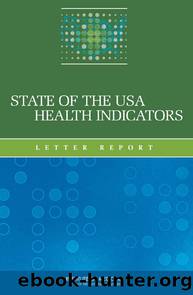STATE OF THE USA HEALTH INDICATORS: LETTER REPORT by Institute of Medicine of the National Academies

Author:Institute of Medicine of the National Academies
Language: eng
Format: epub
Tags: Health and Medicine : Public Health and Prevention. Health and Medicine : Policy, Reviews and Evaluations
Publisher: NATIONAL ACADEMY PRESS
Published: 2009-02-17T00:00:00+00:00
Preventive Services
Indicator: Percentage of adults who are up-to-date with age-appropriate screening services and flu vaccination. Clinical preventive services include health care interventions designed to prevent the occurrence of disease or to detect disease that is already present. The term clinical refers to the fact that these services are provided to individuals one at a time, usually in clinical settings, rather than to communities or populations. Immunizations are a classic example of preventive services; colonoscopy is a clinical service that is considered both screening and prevention because pre-cancerous lesions can be removed before colon cancer develops. The term âscreeningâ refers to the use of one or more diagnostic tests to detect disease in an early stage, before it causes symptoms and before it has caused serious or irreversible health problems. Clinical preventive services also include counseling and chemoprophylaxis.
Screening services have been found to improve health and reduce health care expenditures. For example, HIV screening in pregnant women greatly decreases mother-to-child transmission rates (Chou et al., 2005) and mammography has reduced mortality rates from breast cancer in women 40â75 years of age (Humphrey et al., 2002). According to the CDC, âPreventive screenings are an important part of health promotion efforts. Many preventive screenings have been recognized as a cost-effective way to identify and treat potential health problems before they develop or worsenâ (CDC, 2007b). A study by Maciosek and colleagues (2006) that studied the health impact and cost-effectiveness of colorectal cancer screening found that for people aged 50 and older, screening for colorectal cancer at recommended intervals would prevent 18,800 deaths. They concluded that âcolorectal cancer screening is a high-impact, cost-effective service used by less than half of persons aged 50 and older.â
Vaccination against influenza is another cost- and health-enhancing measure. The CDC notes, âInfluenza vaccination is the most effective method for preventing influenza virus infection and its potentially severe complicationsâ (CDC, 2008h). Rates of serious illness and death from the influenza virus infection rates are highest among children less than 2 years old, people 65 and older and those with serious medical conditions. From 1990 to 1999 the annual average number of deaths from influenza was 36,000 while from 1979 to 2001 there were 226,000 hospital admissions were associated with influenza (CDC, 2008a). The Advisory Committee on Immunization Practices (ACIP) recommends influenza vaccination for all adults, but especially for those who are at high risk for influenza complications or in close contact with persons at high risk (see Box 3) (CDC, 2008e).
Download
This site does not store any files on its server. We only index and link to content provided by other sites. Please contact the content providers to delete copyright contents if any and email us, we'll remove relevant links or contents immediately.
| Administration & Medicine Economics | Allied Health Professions |
| Basic Sciences | Dentistry |
| History | Medical Informatics |
| Medicine | Nursing |
| Pharmacology | Psychology |
| Research | Veterinary Medicine |
Periodization Training for Sports by Tudor Bompa(7946)
Why We Sleep: Unlocking the Power of Sleep and Dreams by Matthew Walker(6387)
Paper Towns by Green John(4826)
The Immortal Life of Henrietta Lacks by Rebecca Skloot(4274)
The Sports Rules Book by Human Kinetics(4097)
Dynamic Alignment Through Imagery by Eric Franklin(3935)
ACSM's Complete Guide to Fitness & Health by ACSM(3834)
Kaplan MCAT Organic Chemistry Review: Created for MCAT 2015 (Kaplan Test Prep) by Kaplan(3815)
Introduction to Kinesiology by Shirl J. Hoffman(3634)
Livewired by David Eagleman(3547)
The River of Consciousness by Oliver Sacks(3431)
The Death of the Heart by Elizabeth Bowen(3355)
Alchemy and Alchemists by C. J. S. Thompson(3312)
Descartes' Error by Antonio Damasio(3170)
Bad Pharma by Ben Goldacre(3118)
The Gene: An Intimate History by Siddhartha Mukherjee(2942)
The Emperor of All Maladies: A Biography of Cancer by Siddhartha Mukherjee(2942)
The Fate of Rome: Climate, Disease, and the End of an Empire (The Princeton History of the Ancient World) by Kyle Harper(2893)
Kaplan MCAT Behavioral Sciences Review: Created for MCAT 2015 (Kaplan Test Prep) by Kaplan(2832)
